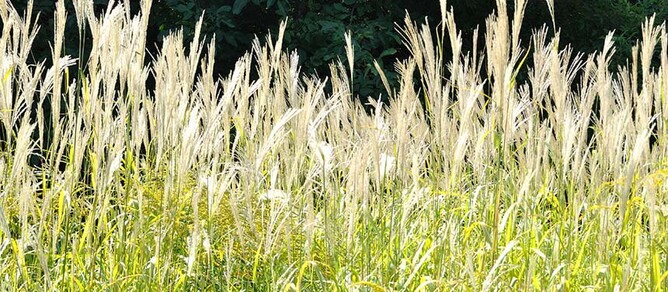Miscanthus is a high yielding crop that annually grows over three metres tall. Similar in appearance to sugar cane, it produces a crop every year without the need for replanting. Miscanthus is used for feedstock production for energy and non-energy end uses. It is a valuable crop, offering major benefits to many sectors, inside and outside of agriculture. It can also be used as animal bedding material and can act as an emergency feed supply during droughts.
Miscanthus grass forms a thick barrier which acts as an excellent wind break and shelter for animals and pasture. Rich green summer foliage is topped by beautiful arching sprays of silky russet pink or white flowers. In winter the foliage takes on a russet gold colour, producing a thick bushy screen that, unlike other forms of screening, does not require pruning or any trimming.
Harvested Miscanthus material can be used to generate heat and power and may be used as a feedstock for advanced biofuels, outperforming maize and other alternatives. The outlook for bioenergy looks positive. It is expected that significant volumes of biomass will be required; some of which will come from energy crops.
The Miscanthus growth pattern is repeated every year for the lifetime of the crop, and the harvest gives an annual income to the farmer. In the first year of growth stems reach up to 1-2 metres in height. Harvesting takes place from the second year, during which the crop can be expected to reach a height of 2.5–3 metres. In subsequent years, it can reach a height of 3-4 metres. The crop has a useful life of at least 25 years. Miscanthus is not invasive like pampas or bamboo. It is a sterile hybrid, so it cannot reproduce itself by seed.
Miscanthus is a perennial C4 rhizomatous grass originating from Asia. It will grow on a wide range of soil types, but higher yields are achieved on free-draining moisture retentive soils. From the end of year two, leaf litter and canopy closure will give effective suppression of most weeds. Harvesting is carried out during late Winter or Spring. The crop is generally harvested using a mower conditioner or forage harvester. It is generally dry when harvested but if necessary, it can be allowed to dry in the field before baling.
The benefits of Miscanthus are that it is high yielding, environmentally friendly, easy to grow and is low maintenance. It is suitable for coastal areas and performs well in windy positions.


